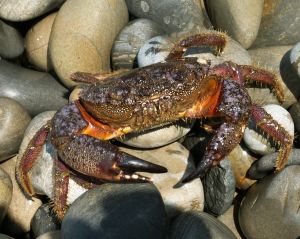Aquarium Crabs
Aquarium crabs can be kept for various reasons. Many species are great scavengers and can help you to keep up the water quality, since they will consume dead and dying organic matter, e.g. left over fish food and decaying plants. Others are kept chiefly for their good looks and fascination behaviors, such as the Red-clawed crab and the Fiddler crab.
The term aquarium crabs is often used to describe a wide range of different aquatic creatures, but it is actually only the members of the infraorder Brachyura in the order Decapoda that is considered true crabs by biologists. The true crabs have five pairs of walking legs, but the first pair has developed into a pair of claws. Most true crab species have flattened shells, and the abdomen is usually folded under the cephalothorax (the first major body section).
As mentioned above, a lot of species that do not belong to the infraorder Brachyura is still sold as aquarium crabs, since they resemble crabs by being short crustaceans with thick exoskeletons and ten legs. In this group of “un-true” aquatic crabs you will for instance find King crabs, Porcelain crabs and Hermit crabs. King crabs, Porcelain crabs and Hermit crabs are all examples of specimens found in the infraorder Anomura. Just like the infraorder Brachyura, the infraorder Anomurabelongs to the order Decapoda. Unlike the true crabs found in Decapoda, the Anomura species do however have their last pair of legs hidden inside the gill chamber, where they are used to clean the gills.
Another species that is often counted among the aquarium crabs is the Horseshoe crab, even though it is actually more closely related to spiders than crabs. It belongs to the family Limulidae and the genus Limulus. Provide your Horseshoe crab with a water temperature between 72 and 78° F, a pH between 8.1-8.4 and a dKH between 8 and 12. It is a peaceful saltwater crab and is therefore popular in reef aquariums.
 Aquarium Crab |
If you have problems with extensive algae growth in your aquarium, you add some of the smaller aquarium crabs to combat the problem. Two popular species used for algae control are the Scarlet Hermit Crab, the Dwarf Red Tip Hermit crab and the Dwarf Zebra Hawaiian Hermit crab. Such aquarium crabs are often sold combined with snails that will consume algae as well.
Didn't find the info you were looking for? Register for free and ask your question in our Aquarium forum !
Our knowledgeable staff usually responds to any question within 24 hours
Related Articles
Amano shrimp- Information about Amano shrimp
Amano Algae Eating Shrimp - An article about the algae eating Amano shrimp
Apple snail - An introduction to apple snails.
Black Mystery Snail - An introduction to the Black Mystery Snail
Breeding Crayfish - basics too crayfish breeding
Breeding of Red Clawed Mangrove Crabs - How to breed red clawed crabs
Freshwater shrimp - Information about Freshwater shrimp
Ghost shrimp - Information about Ghost shrimp
Malaysian Rainbow Shrimp - Information on how to keep and breed this shrimp species.
Red Cherry Shrimp - A guide to this Algae eating shrimp.
Red clawed lobsters - A short overview of red claw lobsters (crayfish)
Red Nosed Shrimp - information on keeping this shrimp in aquarium.
Snails: Friend or Foe in the Aquarium? - The biology of snails. Their advantages and disadvantages in an aquarium. How to keep them in check.
